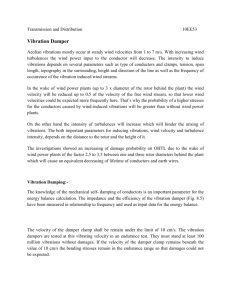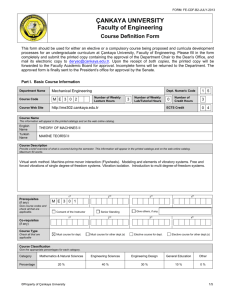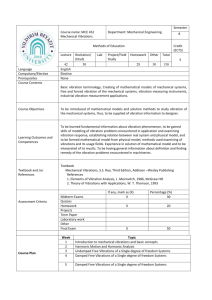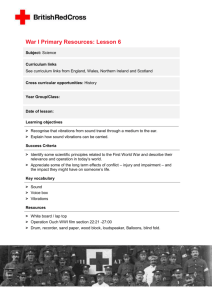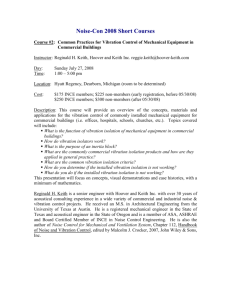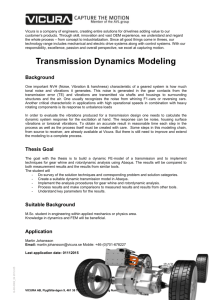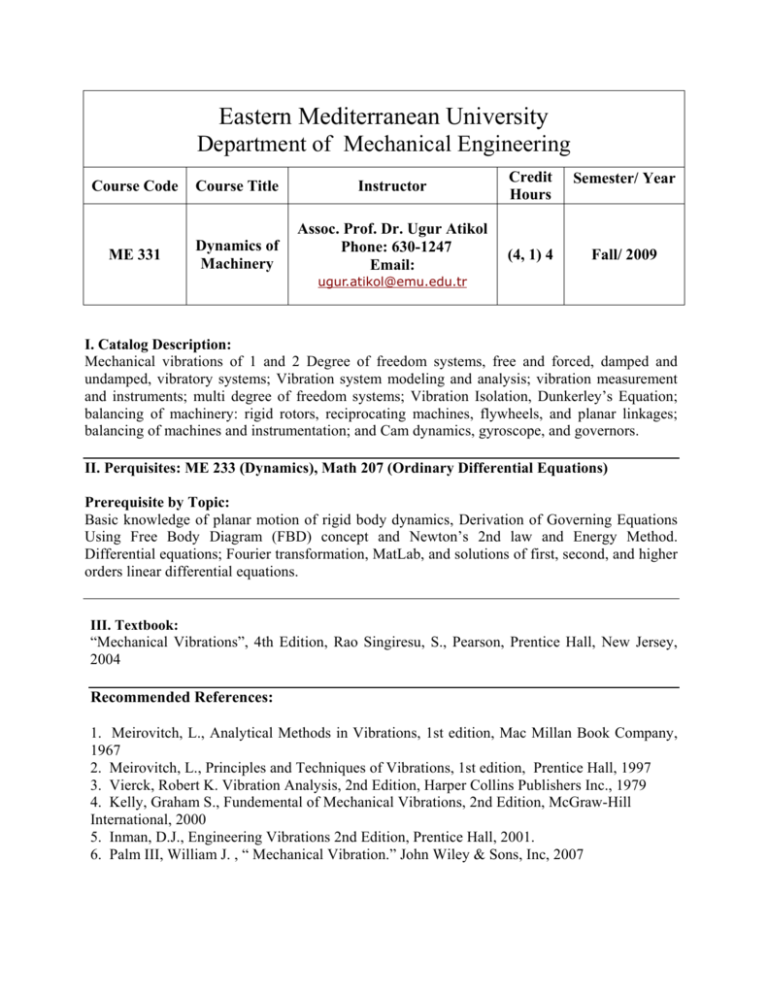
Eastern Mediterranean University
Department of Mechanical Engineering
Course Code
Course Title
Instructor
Credit
Hours
Semester/ Year
ME 331
Dynamics of
Machinery
Assoc. Prof. Dr. Ugur Atikol
Phone: 630-1247
Email:
(4, 1) 4
Fall/ 2009
ugur.atikol@emu.edu.tr
I. Catalog Description:
Mechanical vibrations of 1 and 2 Degree of freedom systems, free and forced, damped and
undamped, vibratory systems; Vibration system modeling and analysis; vibration measurement
and instruments; multi degree of freedom systems; Vibration Isolation, Dunkerley’s Equation;
balancing of machinery: rigid rotors, reciprocating machines, flywheels, and planar linkages;
balancing of machines and instrumentation; and Cam dynamics, gyroscope, and governors.
II. Perquisites: ME 233 (Dynamics), Math 207 (Ordinary Differential Equations)
Prerequisite by Topic:
Basic knowledge of planar motion of rigid body dynamics, Derivation of Governing Equations
Using Free Body Diagram (FBD) concept and Newton’s 2nd law and Energy Method.
Differential equations; Fourier transformation, MatLab, and solutions of first, second, and higher
orders linear differential equations.
III. Textbook:
“Mechanical Vibrations”, 4th Edition, Rao Singiresu, S., Pearson, Prentice Hall, New Jersey,
2004
Recommended References:
1. Meirovitch, L., Analytical Methods in Vibrations, 1st edition, Mac Millan Book Company,
1967
2. Meirovitch, L., Principles and Techniques of Vibrations, 1st edition, Prentice Hall, 1997
3. Vierck, Robert K. Vibration Analysis, 2nd Edition, Harper Collins Publishers Inc., 1979
4. Kelly, Graham S., Fundemental of Mechanical Vibrations, 2nd Edition, McGraw-Hill
International, 2000
5. Inman, D.J., Engineering Vibrations 2nd Edition, Prentice Hall, 2001.
6. Palm III, William J. , “ Mechanical Vibration.” John Wiley & Sons, Inc, 2007
IV. Course Objectives
A student completing this course should be able to do the following:
1. Be able to analyze and formulate a Mechanical Systems for vibration analysis using
Mathematical tools
2. Know how to measure vibrations using analytical and experimental techniques
3. Be able to understand the importance of vibrations analysis in the design of mechanical
systems and machines.
4. Be able to design for resonance condition
5. Be able to design a vibration Isolation system for industrial use
V. Homework/Projects
Selected homework problems will be assigned and collected for grading. An hour-long
Quiz will be given at the conclusion of each chapter. A minimum of five lab reports will be
required.
VI. Relationship of Course to Program Objectives
Relationships of the course objectives to the Mechanical Engineering Department program
objectives
are as shown in the Table below:
VII. Evaluation of Outcomes
Quizzes
Midterm
Exam
Final Exam
Laboratories
Home Works
Attendance
10%
20%
30%
25%
10%
5%
Attendance, Behavior, and Participation are important factors to improve critical letter grades.
EASTERN MEDITERRANEAN UNIVERSITY
DEPARTMENT OF MECHANICAL ENGINEERING
COURSE LEARNING OUTCOMES
COURSE CODE
COURSE TITLE
MENG331
Dynamics of
Machinery
(4, 1) 4
MENG 233
CREDIT VALUE
PREREQUISITES
LANGUAGE OF
English
INSTRUCTION
AIMS
(maximum 100 words in 1 paragraph)
COURSE LEVEL
Undergraduate (1st cycle)
COURSE TYPE
Department Core
ECTS VALUE
COREQUISITES
6
Mechanical vibrations of one and two degrees of freedom systems, free and forced, damped and
undamped, vibratory systems; Vibration system modeling and analysis; vibration measurement and
instruments; multi-degree of freedom systems; Vibration Isolation, Dunkeley’s Equation; balancing of
machinery: rigid rotors, reciprocating machines, flywheels, and planar linkages; balancing of machines and
instrumentation; and Cam dynamics, gyroscope, and governors.
RELATIONSHIP WITH OTHER COURSES
(Describe, if any, using maximum 50 words in 1 paragraph)
This course is perquisite for control system course MENG 332 as well as mechanical Vibration course ME
433. Rigid body dynamics course MENG233 is one of the prerequisite for this course. Knowledge gained
from rigid body dynamics to derive the governing equation of motion for different mechanical systems and
components are utilized as well as knowledge gained for differential equations course MATH201 is
utilized in the solution and interpretation of the solution for the equations of motion of a mechanical
system. Mythology of design and engineering drawing software such as AUTOCAD are used to develop,
design, and build mechanical vibratory system of practical use.
TEXTBOOK(S)
“Mechanical Vibrations”, 4th Edition, Rao Singiresu, S., Pearson, Prentice Hall, New Jersey, 2004
LEARNING OUTCOMES
(List the learning outcomes using action verbs)
On successful completion of the course, the student is expected to develop knowledge and understanding
of:
1. The formulation and analyze of a Mechanical Systems for vibration studies using mathematical
and software tools
2. Vibrations measurement using analytical and experimental techniques
3. The importance of vibrations analysis in the design of mechanical systems and machines.
4. Design knowledge for resonance condition
5. Design of a vibration Isolation system for industrial use
6. also student is expected to develop skills and abilities in
A. Software simulation of mechanical vibratory systems using Matlab and Simulik
B. Design and modelling of the mechanical vibratory system using AutoCAD
C. Teamwork through deign project and laboratory experiments
D. Practical experience through practical design projects
E. To model physical systems for vibrations studies
F. To mathematically derive the governing equations of motion using mathematical modelling
techniques
G. Simulate systems using various software and computer programs
H. To build real life vibratory system for practical usages and applications
I. Design and build vibration pick-up devices such as accelerometer, vibrometer, and Velometer
J. Design vibration isolation systems for industrial and domestic usegaes
7. On successful completion of this course, the student is expected to develop appreciation of:
A. Of mathematical modelling and their applications to real life problems solving and applications
B. Vibratory motion of machines and components and their good and harmful effects
C. Harmonic and periodic motions and the value of Fourier transform in the analysis of general
vibratory systems
D. Critical thinking and crisp understanding of the subject matter and the ability to use information
to formulate solutions
E. Knowledge and power that knowledge brings when dealing with topics that take students to a
higher level of machine control as well as self control
Approved by the Department Board of _____________________________________________
Department
Decision Date: _______________
Decision No.: ______________


